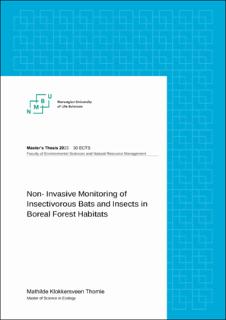| dc.description.abstract | Abstract
1. All the Norwegian bat species depend on forest habitats in some parts of their annual cycle.
Despite many of the Norwegian bat species being categorised as threatened on the Norwegian
Red List and playing key roles as controllers of insect populations, lack of knowledge about
their ecological role in forests leads to them often being overlooked in management decisions.
Bats can be grouped into foraging guilds depending on their foraging behaviors and call
structure. This study focuses on short- range echolocating (SRE) bat species foraging on insects
in open forest habitats.
2. The overall aim of the study is to gain more knowledge about the relationships between SRE
bat activity and insect abundance within boreal forests of varying tree density. More specifically
this study investigates (1) if and how the activity of SRE bats is influenced by forest density
(canopy openness) and environmental variables (temperature, moisture), and if these
relationships differs between feeding and commuting behaviours, (2) if and how the abundance
of insects is influenced by canopy openness and environmental variables, and (3) whether there
is a stronger positive correlation between bat feeding activity and insect abundance than
between bat commuting activity and insect abundance.
3. Data was retrieved from sampling plots located in forest gaps in eleven mixed boreal forest
sites in south-eastern Norway between May and September 2022. Bat activity and insect
abundance were monitored with non- invasive methods, using bat acoustic detectors and insect
camera traps. Site- specific soil moisture and temperature data were sampled using data loggers
deployed into the soil. Hemisphere photos were taken at each site to calculate canopy openness
as a proxy for forest density.
4. Results from this study show that forest density and environmental variables influenced bat
feeding- and commuting activity differently. Bat feeding activity increased with higher canopy
openness and decreased with higher temperatures. Bat commuting activity decreased with
increasing soil moisture and temperatures. Insect abundance was positively influenced by
moisture and had a negative relationship with temperature. The relationship between bat
activity and insect abundance was positively influenced by low canopy openness but
disappeared at higher openness. For commuting behaviour there was no clear relationship
between bats and insects. Results from this study show that there are relationships between
insect abundance and bat activity in forests that can be quantified with non- invasive
monitoring. However, to fully understand this relationship, one must account for the influence
of biotic and abiotic environmental variables.
Key words: Insectivorous bats, flying insects, short- range echolocators, passive acoustic
monitoring, insect camera traps, non- invasive, canopy openness, boreal forests | |
